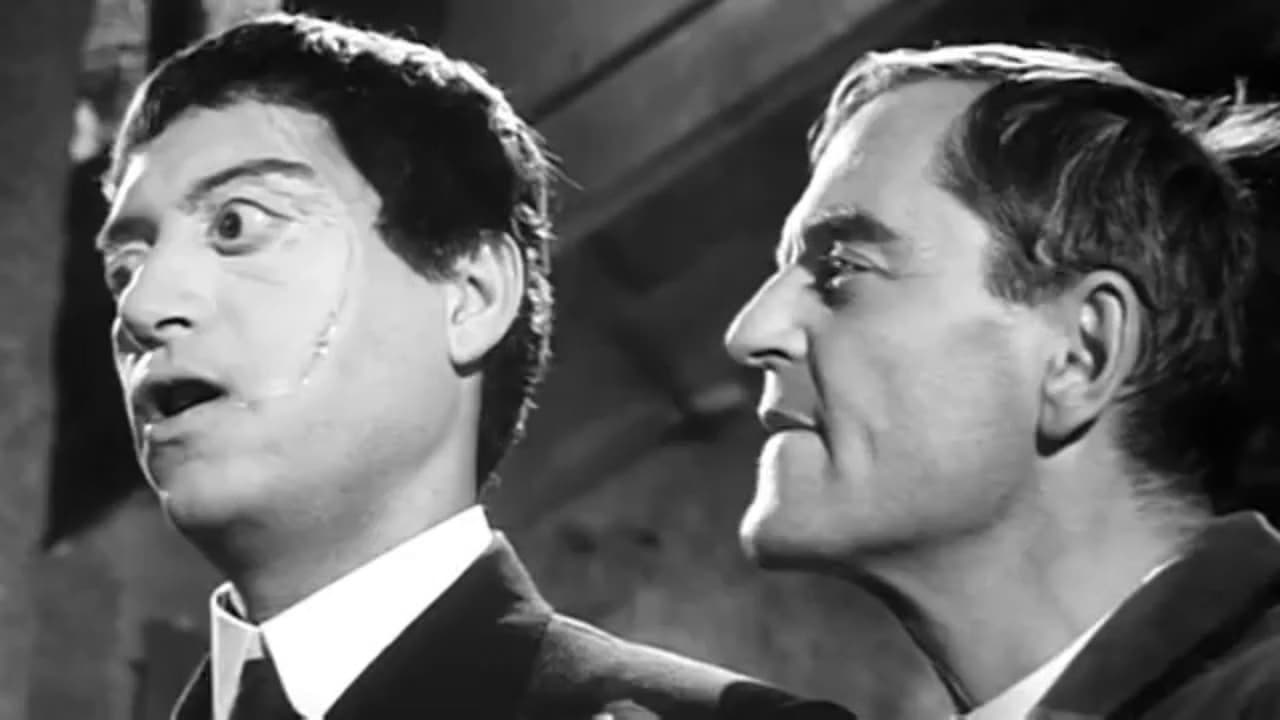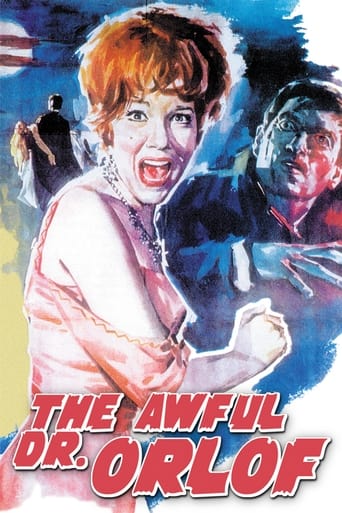

Truly Dreadful Film
... View Moreeverything you have heard about this movie is true.
... View Morebrilliant actors, brilliant editing
... View MoreIt was OK. I don't see why everyone loves it so much. It wasn't very smart or deep or well-directed.
... View MoreHoward Vernon, dapper and hidden in shadows for his first few appearances, abducts silly young ladies in order to transplant their faces onto that of his scarred daughter. Vernon began his long association with Spanish Director Jess Franco with this film, often starring as main characters in often low-budget European horrors after a career playing mainly playing 'gangsters and heavies'. As his billing in mainstream films got lower and lower, his star rose under Franco. Vernon is excellent in this, as he is in all Franco's films – an underrated actor often starring in underrated productions.He plays Orlof, a villain with a smattering of sympathy and a henchman called Morpho (Ricardo Valle). The practicalities of employing a totally blind assistant must be limited – Morpho's scarred, boggle-eyed make-up is not dissimilar from that of the titular monsters in Franco's 'Oasis of the Zombies' twenty years later. The name Morpho would be given to many villainous underlings in future projects.Inspector, Tanner (Conrado San Martín), finds his time divided between this gruesome case and his new fiancée Wanda (who on occasion, bears a resemblance to Yvonne Monlaur's character from Hammer's 1960 hit, 'Brides of Dracula' – a film that inspired Franco to pursue a horror film career). Imagine if Orlof decides that she should be his latest victim! Taking cues from 'Frankenstein', 'Dr Jekyll and Mr Hyde' and especially the French classic 'Eyes Without a Face (1960)' – there's even a black cat thrown in for good measure - this is reputedly Spain's first horror film. It is a chiaroscuro triumph, striking in black and white, almost film noir. Directed with assurance and almost completely lacking Franco's predilection for camera zooms, 'The Awful Dr. Orlof' is the film that put Franco on the map – and deservedly so. Otherwise known as 'Screams in the Night'/'L'Horrible Docteur Orloff', there are few signs of his future in cut-price 'exploitation' that would become his trademarks. An entirely respectable, well played, good looking and confidently produced horror, it ticks all the right boxes and a few more besides.
... View MoreIn 1912, five beautiful easy women are kidnapped and the efficient Inspector Tanner (Conrado San Martín), who is engaged of Wanda Bronsky (Diana Lorys), is assigned to the case. The responsible for the abductions is Dr. Orloff (Howard Vernon), a former prison doctor, and his deformed assistant Morpho Lodner (Ricardo Valle), who was a prisoner sentenced to death and revived by Dr. Orloff, that bring the women to the Hartog Castle to remove the skin of his victims to repair the face of his daughter that was burned in a fire. When Wanda decides to help her beloved fiancé to find the criminal, she becomes the next victim of Dr. Orloff. Now Inspector Tanner's last chance to find Dr. Orloff relies on the lead of the drunkard Jeannot (Faustino Cornejo)."Gritos en la Noche" (a.k.a. "The Awful Dr. Orloff") is one of the best films of director Jesus Franco that I have seen so far. The story combines the story lines of the successful 1960 "Les Yeux Sans Visage" ("Eyes without a Face") with Frankenstein, Jack the Ripper and Sherlock Holmes and the result is good. The cinematography in black and white is great and the acting is decent. My vote is six.Title (Brazil): "O Terrível Dr. Orloff" ("The Terrible Dr. Orloff")
... View MoreI first-watched this on Boxing Day 2004 in the wake of my DVD viewing of Georges Franju's EYES WITHOUT A FACE (1960), which clearly inspired it; being in Spanish with no subtitles, I recall admiring the film's undeniable pictorial qualities but only ended up rating it **1/2 (incidentally, I know I jotted down notes back then but never opened these up into a proper review and, regrettably, I seem to have misplaced them in the interim!). Going through it a second time, in English now (its Spanish origins – again, this was allotted the French "Eurocine" stamp – are given away by the songs being performed in that language), the film proves every bit the solid effort the director's hardened fan-base has always claimed it to be! For the record, I am not sure off-hand how long the original was, or how it may have differed from this current copy, but the latter runs for 83 minutes. Anyway, Franco's fourth feature (but only the Spaniard's first genre outing) is naturally a seminal work within his vast canon but also the "Euro-Horror" movement since the title character (subsequently spelled with an added 'f'!) would become something of an icon and appear in myriad other (though usually unrelated) 'vehicles'! As I said, THE AWFUL DR. ORLOF – by the way, I much prefer the original title, which translates to SCREAMS IN THE NIGHT – looks great (especially given the period setting) but obviously also benefits from lead Howard Vernon (previously relegated to eccentric character parts)'s star-making turn and the presence of his unforgettably bug-eyed assistant Morpho (again, for whatever reason, Franco's filmography is littered with mute and vaguely sinister manservants, sometimes played by the director himself!); incidentally, it was an inspired touch to have Morpho introduced emerging from a closet and, needless to say, his nightly rampages for fresh victims constitute some of the film's definite highlights. The "DVD Savant" review rightly remarks of the incongruity of Morpho's condition to diligently carry out his tasks (for one thing, he has to be guided by Orlof's tapping of his cane!), but is not that part of what makes these films endearing to begin with?!; similarly, Morpho regularly attacks his victims by biting their necks ("Savant" suggests this is an externalization of the audience's own desires, with the obvious detachment represented by the assailant's own disability!) which, blind as he is, he might damage their visage...then where would he (and, more importantly, Orlof) be?! Two other recurring devices (which I also denoted in reviews of recently-viewed titles by this notorious exploitationer) are the chanteuse and the cop (a Police Procedural sequence here, unfolding two very diverse identikits of the presumed assailant, would virtually be replicated wholesale in Franco's much-later JACK THE RIPPER {1976} who even gets stuck with the Orloff moniker!). In this case, however, they are adopted by the figures of the heroine (played by the stunning Diana Lorys, with whom Orloff becomes obsessed because apparently she looks like his daughter: the actress was later the protagonist of NIGHTMARES COME AT NIGHT {1970}, dealing with another much-reworked Franco premise i.e. the hypnotized assassin) and hero (called Tanner, who also recurs a lot in Franco's oeuvre though, typically, he is depicted as lacking the insight to be anything like the villain's equal, when he decides to shun a letter – even if it keeps turning up – until it is nearly too late!).The plot, then, is among the first to rehash the afore-mentioned Franju masterpiece: practically contemporaneously there were MILL OF THE STONE WOMEN from Italy and THE WITCH'S MIRROR from Mexico – the three of them, along with Franco's own subsequent THE DIABOLICAL DOCTOR Z (1965) and the French-made THE BLOOD ROSE (1969), actually constitute the best of countless variations over the years though none really came close to recapturing the deft (one might even say, audacious) mix of haunting poetry and in-your-face realism that marked the original. One significant shortcoming here is that the fire-victim daughter whose face Orloff intends to restore remains nothing more than a cypher throughout, being confined to a bed the whole time and deemed of only a handful of shots along the way (unlike the poignant Edith Scob, with her eerie blank mask, in EYES WITHOUT A FACE)! In the end, Orloff commits an imprudence by eliminating another (female) aide when objecting to more killings and especially his assertion that, for the operation to be a complete success, the face-grafting has to be done when the (unwilling) donor is still breathing! Since she had been sympathetic to Morpho, he rebels and cuts short Orloff's plans – and life – when inconveniently (indeed literally) stumbling upon her body at the climax! When he takes up the abducted Lorys to the roof of Orloff's castle (his intentions unclear – is he going to toss her over the walls or will he be keeping her as a personal prize for his pains?), Morpho is promptly shot by the nick-of-time arrival of the hero – a scene which is practically recreated in the first loose sequel to the film, namely DR. ORLOFF'S MONSTER (1964; also helmed by Franco).
... View MoreThis originally played on the bottom half of a double-bill toplining "The Horrible Dr. Hichcock" (note: NO *t* in "Hichcock) and was a bonanza for every theater that played it, especially the drive-ins: I saw it at a drive-in in Rhode Island near Narragansett August '64, which was a cool '60s summer spot---they even had a race track (thoroughbreds, not NASCAR). Featuring a classic ad campaign---the one-sheets in mint condition are prized by collectors---this twin-bill followed a well-established trajectory for independent "exploitation" films: Played drive-ins Memorial Day to Columbus Day, then regular theaters ("hard tops" in trade lingo of the era) from Thanksgiving through New Year's. It topped the box-office grosses (reported in weekly Variety) when it broke wide in New York and Chicago Thanksgiving 1964. Unusually for such a tandem, both films fully delivered on their opening premise : mad doctor goes off the rails with his obsessions. "Hichcock" was director Freda's best---the U.S. version was only 76 min., the original ran 88 min---I saw this latter when I lived in London 1969, and was surprised that the English version had dubbing by English voices: this is *definitely* the version to get. I am aware that certain Franco aficionados regard this first "Dr. Orloff" as his best---I think "Succubus" aka "Necronomicon" ( in U.S. '68, Trans-American Films, subsidiary of A.I.P.) is and I saw it at its N.Y.C first run at the 59th Street East Theater, though I'd like to see ·VENUS IN FURS aka "Paroxismus" ('69)again, as well as 99 WOMEN ('69) aka "Island Of Despair", as well DIABOLICAL DR. Z ('66). I never trust home-viewing to give the full measure of a film---films of the pre- 1980 era were made with the theatrical audience firmly in mind. That goes double for B & W horror sci-fi. Like "The Awful Dr. Orloff". All other posts here note the similarity to what they call "Les Yeux Sans Visage". That film saw release as "Horror Chamber Of Dr. Faustus" ('62, Lopert Films through UA) with "The Manster". I was aware of the original title because at the time I got the French film mags "Positif" and "Midi Minuit Fantastique". For French class in high school I would do film reviews of these horror films and quote these mags while the other kids were reviewing "The 400 Blows" (*hawk-ptoo*), "Jules And Jim" (*barf*) and other flicks that were WAY too sensitive for my crude and primitive mental process. Franju's classic did not hit the U.S. with its original title until the late '80s, with the advent of the dvds catering to film"buffs". It is more plausible to point to "Circus Of Horrors" ('60) as a primary influence since it was a much bigger hit worldwide , by far. Same set-up: Mad surgeon undone by his obsessions. Since I've only seen "Awful Dr. Orloff" at home recently, I must reserve judgment. I'm very "high church" about that---the small screen experience is nothing like the impact of a theatrical viewing. This films was, and remains, ruggedly serviceable of its type. If you go for '60s mad doctor films, and relish black & white, this will fully satisfy. Others looking for more gore should stick with the post-1980 product.
... View More